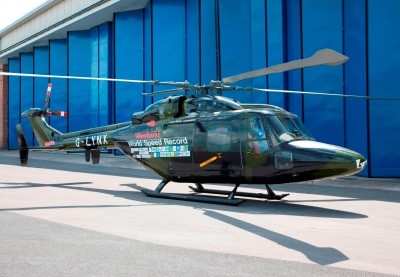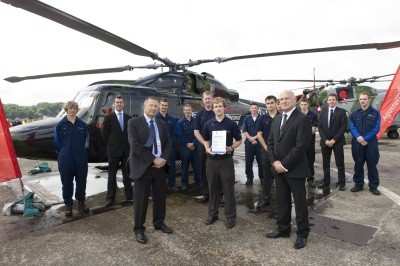Four-Year Restoration Completed, Aircraft Unveiled Friday
After a four year restoration program undertaken by a team of
AgustaWestland apprentices, the record breaking Westland Lynx
helicopter, which is still the official holder of the helicopter
World Speed Record, was unveiled Friday by AgustaWestland’s
CEO Bruno Spagnolini and apprentices to employees gathered at
AgustaWestland’s Yeovil factory.

“To have held the world helicopter speed record for 25
years highlights what an outstanding achievement it was by all
those involved in the project and the development of the rotor
blade technology that was key to the successful record attempt,"
said AgustaWestland CEO Bruno Spagnolini after the unveiling. "The
apprentices are to be also congratulated on performing an excellent
restoration of this historically important helicopter, it is their
skills and knowledge that will help keep AgustaWestland at the very
forefront of rotorcraft technology for the next 25
years.”
Following its World Record breaking flight in 1986 the aircraft
went on to become the test bed for CTS800-4N engines and was
heavily modified before finally being retired from development
flying in 1991. In January 1995 the helicopter was donated to the
Helicopter Museum where it was preserved and put on public display,
then in 2007 AgustaWestland agreed to undertake the restoration of
the aircraft back to its World Speed Record configuration. The
aircraft returned to Yeovil, where it was originally built, and the
team of apprentices set about the major task of restoring the
aircraft to as close a condition as possible to that on its record
breaking flight.
The team of AgustaWestland apprentices have spent over 25,000
hours researching the configuration of the aircraft, de-modifying
the aircraft, locating the original parts wherever possible,
sourcing missing parts, rebuilding the aircraft and finally
repainting it in its distinctive world speed record colors with all
the logos of those companies that assisted the original
project.
August 11th marks the 25th anniversary of the Westland Lynx
helicopter setting a new world helicopter speed record of 249.1
mph. The Lynx helicopter, registered G-LYNX, flew an 8 nm course
across the Somerset Levels at 500 ft on a calm hazy evening back in
1986 with Chief Test Pilot Trevor Egginton at the controls and
Derek Clews, Flight Test Engineer alongside. The average speed
achieved over two runs was 249.1 mph, beating the record held by a
modified Mil “Hind” helicopter by over 20 mph.

The world record flight was made possible by the use of advanced
technology composite rotor blades developed as part of the British
Experimental Rotor Program (BERP) project. The BERP program was
carried out in co-operation with the UK Ministry of Defence to
produce an advanced technology rotor blade, which exploits the
advantages to be gained by aerodynamic tailoring through the use of
modern composite materials and construction methods. The first BERP
blades were flown on 9th August 1985 and such was the progress
achieved G-LYNX was able to claim the World Speed Record just one
year later. Production versions of the original BERP blades are now
fitted to all Lynx helicopters in service and the same technology
is used for the AW101 main rotor blades. To this day AgustaWestland
continues to be at the very forefront of rotor technology and is
currently developing new rotor blades that will incorporate active
blade technology to reduce noise and be more efficient, thereby
reducing fuel consumption.
The three month program to modify a standard Lynx to world speed
record configuration was launched on in May of 1986 and included
installing more powerful Rolls-Royce Gem 60 engines. These engines
were cleared to operate at their maximum contingency rating,
thereby boosting power by 45%. Engine power was further boosted by
utilising a water-methanol injection system. To improve yaw control
a new low set tail plane with vertical fins was fitted which also
offload the tail rotor.
A drag reduction exercise was undertaken involving the fairing
of the main rotor head, removal of external items such as steps,
aerials and windscreen wipers, while joints were sealed and cooling
ducts blanked where possible.
Later this month “G-LYNX” will return to The
Helicopter Museum in Weston-super-Mare, the world’s largest
collection of rotorcraft with over 90 helicopters in its
collection, where it will be put on public display alongside
an original WG13 Lynx prototype.
 ANN's Daily Aero-Linx (04.16.24)
ANN's Daily Aero-Linx (04.16.24) Aero-News: Quote of the Day (04.16.24)
Aero-News: Quote of the Day (04.16.24) Airborne 04.10.24: SnF24!, A50 Heritage Reveal, HeliCycle!, Montaer MC-01
Airborne 04.10.24: SnF24!, A50 Heritage Reveal, HeliCycle!, Montaer MC-01 Airborne 04.12.24: SnF24!, G100UL Is Here, Holy Micro, Plane Tags
Airborne 04.12.24: SnF24!, G100UL Is Here, Holy Micro, Plane Tags Airborne-Flight Training 04.17.24: Feds Need Controllers, Spirit Delay, Redbird
Airborne-Flight Training 04.17.24: Feds Need Controllers, Spirit Delay, Redbird




